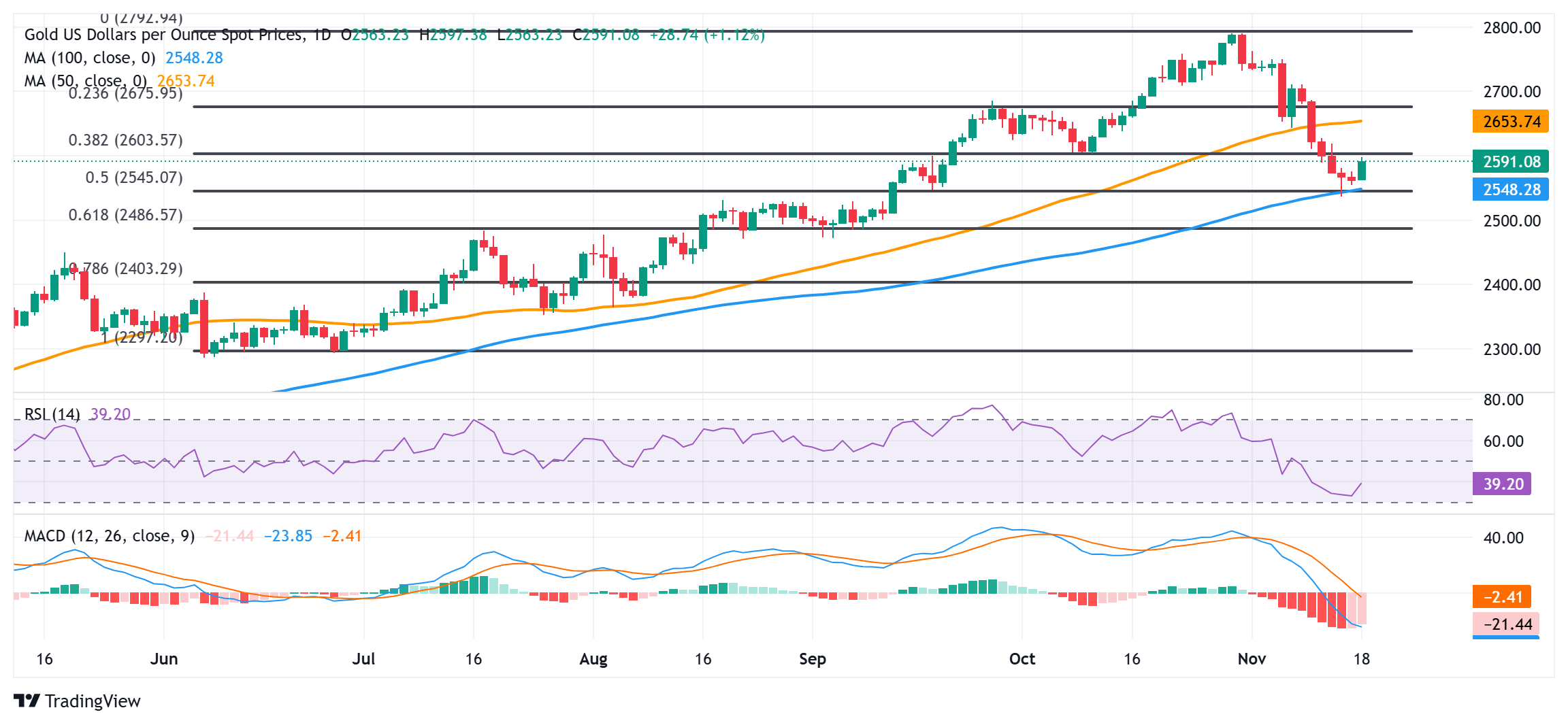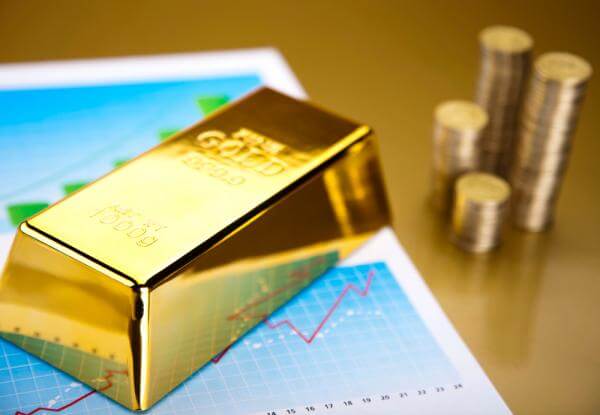Gold price advances closer to $2,600 on geopolitical risks, subdued USD price action


- Gold price attracts some haven flows on Monday amid rising geopolitical risks.
- The USD remains on the defensive below a one-year high and also lends support.
- Bets for less aggressive Fed rate cuts and elevated US bond yields to cap gains.
Gold price (XAU/USD) gains strong positive traction on Monday and reverses a part of last week's sharp decline to the lowest level since September 12. The commodity, for now, seems to have snapped a six-day losing streak and is supported by reviving safe-haven demand, bolstered by the risk of a further escalation of geopolitical tensions. Apart from this, subdued US Dollar (USD) price action is seen as another factor offering some support to the precious metal.
The upside for the Gold price, however, seems limited in the wake of expectations that US President-elect Donald Trump's policies will likely rekindle inflationary pressures and limit the scope for further rate cuts by the Federal Reserve (Fed). This has been a key factor behind the recent upsurge in the US Treasury bond yields, which should continue to act as a tailwind for the Greenback and keep a lid on any meaningful appreciation for the non-yielding Gold price.
Gold price benefits from geopolitical risks; bulls seem non-committed amid less dovish Fed
- Gold price registered its biggest weekly decline since September 2023 and dropped to over a two-month low last week amid the recent strong US Dollar rally to over a one-year high.
- Geopolitical developments over the weekend drove some haven flows and assisted the precious metal to gain strong positive traction during the Asian session at the start of a new week.
- US President Joe Biden authorized Ukraine to use US-supplied long-range missiles to strike deeper inside Russia, which has deployed North Korean troops to reinforce its war.
- A Russian attack on a nine-story building killed at least eight people in the northern city of Sumy. Russia also launched a massive drone and missile attack targeting energy infrastructure.
- Israeli forces killed at least 111 Palestinians in the Gaza Strip on Saturday and continued military operations in Lebanon after assassinating Hezbollah’s top media relations officer, Mohammad Afif.
- Investors now seem convinced that President-elect Donald Trump's tariff plans and debt-funded tax cuts would stoke inflation, potentially slowing the Federal Reserve's rate easing cycle.
- Fed Chair Jerome Powell said last Thursday that there’s no need to hurry into cutting interest rates amid a resilient economy, a strong job market, and inflation still above the 2% target.
- Boston Fed President Susan Collins said in an interview that another rate cut in December is on the table, but it is not a "done deal" and that there's no preset path for monetary policy.
- Separately, Chicago Fed President Austan Goolsbee noted that as long as we keep making progress toward the 2% inflation goal, rates will be a lot lower than where they are now.
- The yield on the benchmark 10-year US government bond stands firm near a multi-month peak, which favors the USD bulls and might cap gains for the non-yielding yellow metal.
Gold price climbs closer to $2,600 after defending 100-day SMA / 50% retracement confluence

From a technical perspective, the recent sharp pullback from the all-time peak stalled near the 50% retracement level of the June-October rally. The said support, around the $2,536-2,535 area, coincided with the 100-day Simple Moving Average and should now act as a key pivotal point. A convincing break below will be seen as a fresh trigger for bearish traders and pave the way for further losses. The subsequent downfall could drag the Gold price further towards the $2,500 psychological mark en route to the 61.8% Fibo. level, around the $2,480 region.
On the flip side, any subsequent strength above the $2,600 mark (38% Fibo. level) is likely to confront stiff resistance and remain capped near the $2,620-2,622 region. Some follow-through buying, however, could trigger a short-covering rally towards the $2,655-2,657 congestion zone, or the 50-day SMA, en route to the $2,672-2,673 region (23.6% Fibo. level). A sustained move beyond the latter might shift the bias in favor of bulls and allow the Gold price to reclaim the $2,700 round figure.
Gold FAQs
Why do people invest in Gold?
Gold has played a key role in human’s history as it has been widely used as a store of value and medium of exchange. Currently, apart from its shine and usage for jewelry, the precious metal is widely seen as a safe-haven asset, meaning that it is considered a good investment during turbulent times. Gold is also widely seen as a hedge against inflation and against depreciating currencies as it doesn’t rely on any specific issuer or government.
Who buys the most Gold?
Central banks are the biggest Gold holders. In their aim to support their currencies in turbulent times, central banks tend to diversify their reserves and buy Gold to improve the perceived strength of the economy and the currency. High Gold reserves can be a source of trust for a country’s solvency. Central banks added 1,136 tonnes of Gold worth around $70 billion to their reserves in 2022, according to data from the World Gold Council. This is the highest yearly purchase since records began. Central banks from emerging economies such as China, India and Turkey are quickly increasing their Gold reserves.
How is Gold correlated with other assets?
Gold has an inverse correlation with the US Dollar and US Treasuries, which are both major reserve and safe-haven assets. When the Dollar depreciates, Gold tends to rise, enabling investors and central banks to diversify their assets in turbulent times. Gold is also inversely correlated with risk assets. A rally in the stock market tends to weaken Gold price, while sell-offs in riskier markets tend to favor the precious metal.
What does the price of Gold depend on?
The price can move due to a wide range of factors. Geopolitical instability or fears of a deep recession can quickly make Gold price escalate due to its safe-haven status. As a yield-less asset, Gold tends to rise with lower interest rates, while higher cost of money usually weighs down on the yellow metal. Still, most moves depend on how the US Dollar (USD) behaves as the asset is priced in dollars (XAU/USD). A strong Dollar tends to keep the price of Gold controlled, whereas a weaker Dollar is likely to push Gold prices up.


